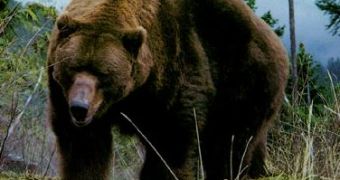The grizzly bear is nothing more than the North American form of the Eurasian brown bear. Once, the terrible grizzly bear was in the whole western half of North America, from Alaska to northern Mexico. Today, it is still present in Alaska and Canada, while in the rest of the US it barely survives in Montana, Washington, Idaho and Wyoming (except Yellowstone). This large bear inhabits from tundra to forests.
The female gives birth during the "hibernation" (bears do not really hibernate, but spend the winter in a somnolence state), between January 5th to February 15th, to 1-4 cubs. The family goes out of the den by April-May. During the first year, the cubs "hibernate" with the mother, remaining with her till the next mating season, in June-July.
The young remain in a family group till the age of 5. When the young from two families unite, they form a larger group of young grizzly. Sexual maturity is reached by the age of 8-10 years, and grizzly bears can live up to 30 years.
Grizzly bears do not get out from their "hibernation" being weaken, but quite clean and fat. Still, they lose from the fat reserves, and in the spring they can be seen grazing like cows. In the northern areas, where the vegetation does not grow up so quickly, they dig for chipmunks (Tamias striatus), which really hibernate. Grizzly bears consume chipmunks also late in the fall, when they cannot find plant food anymore because of the freeze.
During the fall, the grizzly bears also consume cranberries, hazelnuts, acorns, salmons, trouts, and carrion. They also consume earthworms and insects, including ants, clawing the bark of the rotten trees on their search. While looking for small animals, grizzly bears turn over rocks that humans cannot even stir. Still, grizzly bears have a meat tooth, and will attack elks, deer, moose, bisons, bighorns or wild goats. There are even recorded cases of grizzly bears killed by bison bulls.
Because they attack sheep and cattle, they have been exterminated in many zones (like California, Arizona, New Mexico). The brown bear itself is menaced, being extremely in danger in France, Spain and Italy. In Greece, bears are in conflict with bee keepers and farmers, while the largest number of brown bears in Europe (except Russia) are found in the Romanian Carpathians (about 5,000). In Russia, there are 36,000 brown bears, and about 3,000 in the Japanese Hokkaido Island.
Grizzly bears have an average length of 6 ft (1.83 m), while their weight varies between 145 to 453 kg (322 to 1,006 pounds). Polar bears have on average 410 kg (911 pounds) for males and 320 kg (711 pounds) for females, the record being a one ton (2.200 pounds) individual. In some Alaskan grizzly populations, the average weight is even higher than 410 kg, making those bears the largest living carnivorous mammals. In the island of Kodiak (Alaska) (with a surface of 6,400 square km), there are the largest bears in the word, a population of 3,300 individuals. This means one bear for each 200 hectares. Such high density is due to the abundance of food represented by salmons., which lay their eggs in rivers and streams.
Usually, these animals are peaceful, but if provoked or wounded, it can be terrible, and once it killed and mutilated many hunters in the Wild West. The female is also extremely aggressive with anything that looks like a threat for her cubs. Normally healthy and unwounded animals avoid humans.
Like all bears, the grizzly has a fine smell and hearing. They are said to be short-sighted, but they can detect a human from a distance of 100 m (330 ft).
Like the brown bears, the grizzly has a "hump" and concave face. The claws are 7-8 cm (3 in) long! The name "grizzly" comes from the light tips of their fur hairs, which give them a gray look. But this is not obvious in all individuals, and their color varies from yellowish to various brown hues and even black, some having a pattern similar to black bears (which are much smaller).
The grizzly can have a top speed of 30 mi (50 km) per hour; young are agile tree climbers, but the adults are too heavy. They can also swim very well.
These bears are not territorial, but the males will fight fiercely for the right of mating, even to death. Also, accidents, diseases and hunger kill a lot of grizzly bears. Many young die before reaching maturity.

 14 DAY TRIAL //
14 DAY TRIAL //